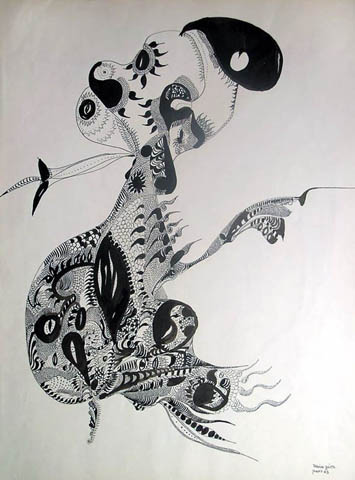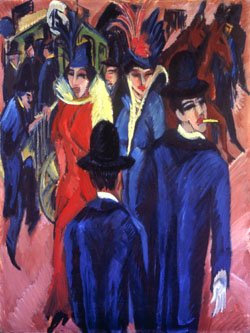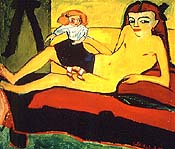
Paolo Roversi,
Blue Mask, Paris 2007, Another Magazine
Weird Beauty: Fashion Photography Now, currently on view through May at the
International Center of Photography, offers a dizzying crash-course on contemporary fashion photography - and an unrelentingly barrage to the eye and the senses. Divided into fourteen sections, the exhibit is presented in a floor-to-ceiling format of mounted, unframed prints and magazine tearsheets from well-known fashion magazines, as well as more obscure foreign publications. Offering up a visual overload of photographic candy, the sections are more a hodgepodge of images rather than a cohesive representation of distinct stories or subthemes. Given the limited amount of exhibition space, some prints were mounted near the top of the walls making for many a sore neck - and making it very difficult to make out the images properly. Although the curatorial decisions were questionable, it presents a tantalizing glimpse into the changing medium of fashion photography as it own genre, distinct from the separate entities of fashion and photography but also the product of the merging of the two influences.
Historically, modern fashion and art has always applauded the weird, which would encompass not the conventional acceptance of beauty, but alternative views of it: the eccentric, the avant-garde, the quirky, the awkward, the slightly off-beat and off-center world that turns to underground influences of music, art, politics and discourse. Some images in the exhibition did not appear to fit within the realm of weird beauty, such as the commercial Victoria and David Beckham spread,
Steven Meisel’s pretty pastel makeup editorial or the tame
In the Bedroom series that showed women in undergarments posing provocatively on a bed, displaying a detached boredom that is already commonplace in fashion photography.
Richard Prince's magazine cover collaboration with
W in November 2007 also seemed out of place in the exhibit. The
All The Best series were ten unique “signed” covers, featuring paparazzi shots of celebrities who have been the subject of much gossip magazine fodder, such as Katie Holmes, Madonna, Lindsay Lohan, Britney Spears and Angelina Jolie, the last of which was included in the show. More a commentary on the attempt to reconcile high art and popular culture, as well as a criticism of the commercialization of art and fashion, it does not seem to work well within the show’s theme. Shifting between the commercial and the cutting-edge made for a disorienting experience, but it was a reminder that beauty is subjective and that the weird has penetrated the mainstream in fashion, as well as photography.


Miles Aldridge's
Immaculee series
Despite the often confusing and apparently haphazard placement of the exhibition, it did offer some wonderful examples of the merging aesthetics of fashion and photography. The exhibit opens with a
Karl Lagerfeld piece (
Mademoiselle, 2008), which is a close-up portrait of (presumably) a courtesan. Her face is decorated with exaggerated pink cheeks, darkened eyebrows, and garish red lipstick hurriedly applied outside of the lip’s confines. The lace strap of her undergarment is pointedly visible beneath her blouse, suggestive of a state of undress and sexual availability. A tiara is placed upon her head, which is an indication of wealth, prestige and of the upper class – a life that this woman clearly does not lead. She lives on the outskirts of society, but there is an appealing, otherworldly quality to such outcasts that make them relatable in their differences.
In addition, if considered next to
Miles Aldridge’s Immaculee photographic story (
Numero, May 2007) shown later in the exhibit, which plays on art historical depictions of the Virgin Mary complete with a head piece, the “tiara” can also be understood as a halo. Lagerfeld’s head piece, however, appears almost garish next to the elaborate gold spiked headdress (perhaps even alluding to Christ’s crown of thorns) featured in Aldridge’s work. Aldridge’s use of matte, pale and minimal makeup gives the figures a waxy or plastic appearance, as if they were manufactured icons. These figures have tears on their faces or eyes directed upward, perhaps indicating the distress and grief of the Pieta. However, the vacant stares and strangely odd parted mouths of these women turn them into modern Virgin Marys with more of a story – and secrets - to tell. Both Lagerfeld and Aldridge focus on the face and not so much the clothing to be advertised, thereby depending on the potent content of the images to resonate with the viewer. The fashion presented appears secondary to the story and images, but this plays onto modern fashion photography’s artistic and often cheeky use of art and history to complement and elevate the garments to art itself.

Tim Walker's
Alice Gibb and Olga Sherer, Sennowe Park, Norfolk, England, November 2007The sense of otherworldliness continues with
Tim Walker’s work,
Alice Gibb and Olga Sherer, Sennowe Park, Norfolk, England (November 2007; shown above). The series is perhaps best characterized by an image of two impossibly tall, slim, long-limbed, unearthly figures standing on a platform like ancient Greek statues. The sparse white platform and background, and the pure white lighting intensify the allure of these unearthly figures. The one on the right dons a filmy, transparent white layered garment and stockings, with the sheerest hint of a female body beneath. The frothy, tulle pouf-like garment on the left that appears to glow from within coupled with the awkward twig-like effect of her unnaturally thin arms and legs, is a purely ethereal image of unattainable beauty. The forms do not even cast shadows on the floor, with the only suggestion of depth found in the folds of the garments and the shadows on their legs that only further delineate and emphasize their unnaturally long limbs. The figure on the left is propped up by posts at the leg and arm while the second figure is supported by the wall and a hand outstretched to the hip of her companion. Despite this suggestion of weight, their sheer attire and abundance of white in the shot lends a sense of unnatural weightlessness, which further makes these “women” even more unattainable.


Steven Klein's
Le Goût des Robes, Vogue ParisSteven Klein’s vibrant editorial,
Le Goût des Robes, Vogue Paris (October 2007) pairs richly ornate patterned and beaded Versace and Dior gowns against the backdrop of an ordinary, conventional supermarket. Using a grocery store as a location with bored and wealthy housewives has been captured before, but Klein’s uncanny juxtapositions of color and pattern provides a rather striking play on the eye. In particular, one of the images features woman dressed in a royal blue Louis Vuitton patterned dress with a draped, beaded yoke and sleeves over pink floral tights. She is splayed out across a grocery shopping cart, her legs slightly parted in a suggestively sexual manner and placed next to a display of various neatly packaged meats, the parallel of woman as an object (or a piece of meat to be devoured) are unmistakable. The contrast of high class glamour and the women’s societal position (evident by the perfectly coiffed hair, carefully selected jewelry and expensive clothing) and the everyday market immediately tells us that this is not a part of our common reality. The figures’ unearthly paleness and disengaged gazes, as well as the high contrast manipulation of the photograph’s colors lend it an unnatural feel, further distancing the image from general norms. In addition, the first photograph shows two women entering the market against a backdrop of colorful bottled drinks, with the “Do Not Enter” sign at the sliding door just visible beyond them. This sign suggests that the women are above conventional behavior and thought. They are prone to disregarding rules, but do follow a subversive understanding of reality that is beyond the common individual. This detail may also be directed to the viewer, telling us that we as ordinary individuals are not allowed access into this exclusive world.


Cindy Sherman,
Merci CindyAny fashion photography exhibit could not be considered complete without the addition of
Cindy Sherman’s works. Featured in the show is
Merci Cindy (Vogue Paris, August 2007) that shows Sherman in several guises, all middle-aged women in what can be assumed to be a nightclub or bar. The first image provides a jarring contrast of a short dark-haired woman, her advanced age feebly masked by smudged, overdone eyeliner, over-plucked eyebrows, and bright lipstick paired with dark lipliner, which all serve as reminders of her aging and fading beauty. The optic patterned dress and the neon fur collar of her patterned coat is fit for someone much younger, also signifying denial of her age. Another image features another with a bobbed haircut, complete with oversized, Peggy-Guggenheim-approved eyeglasses and yet another woman wearing a revealing patterned dress with perfectly done nails, her hand pointing to herself and her eyes directed at the viewer beseechingly. All of the images emphasize the defined creases around her lips and face that belie the use of makeup, which is inexpertly applied and caked-on, and appear a tad shade off. She appears available and eager to interact with others, but her attempts to revive her youth are much too obvious and sad to be welcoming to others. The addition of this spread provides a sympathetic look at the protagonist and shows a woman reclaiming her former youth as being beautiful. However, as this exhibition has shown, it is not the conventional image of beauty that we know, but the beauty found in art – the beauty of history, of outcasts and the depraved or emotionally unstable, and of that which is found outside of the confines of our own realities so that we may see ourselves within them. That is, a greater truth of what constitutes beauty.

































